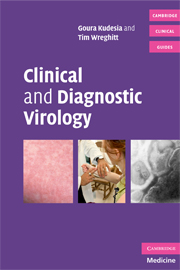Book contents
- Frontmatter
- Contents
- List of plates
- Preface
- Acknowledgements
- SECTION 1 INDIVIDUAL VIRUSES
- Introduction to virology
- 1 Adenoviruses
- 2 Arboviruses and haemorrhagic fever viruses
- 3 Cytomegalovirus (CMV)
- 4 Epstein–Barr virus (EBV)
- 5 Enteroviruses
- 6 Hepatitis A virus (HAV)
- 7 Hepatitis B and D viruses (HBV and HDV)
- 8 Hepatitis C virus (HCV)
- 9 Hepatitis E virus (HEV)
- 10 Herpes simplex virus (HSV)
- 11 Human immunodeficiency virus (HIV) and acquired immunodeficiency syndrome (AIDS)
- 12 Human herpes viruses types 6, 7 and 8 (HHV 6, 7 and 8)
- 13 Human T-cell leukaemia virus (HTLV)
- 14 Influenza viruses
- 15 Measles virus
- 16 Mumps virus
- 17 Noroviruses
- 18 Parainfluenza viruses
- 19 Papilloma and polyoma viruses
- 20 Parvovirus B19
- 21 Pox viruses
- 22 Rabies virus
- 23 Respiratory syncytial virus (RSV)
- 24 Rhinoviruses
- 25 Rotavirus
- 26 Rubella virus
- 27 SARS CoV and other coronaviruses
- 28 Varicella-zoster virus (VZV)
- SECTION 2 OTHER RELATED AGENTS
- SECTION 3 CLINICAL SYNDROMES
- SECTION 4 DIAGNOSTIC TECHNIQUES
- SECTION 5 PATIENT MANAGEMENT
- Index
- Plate section
17 - Noroviruses
Published online by Cambridge University Press: 07 December 2009
- Frontmatter
- Contents
- List of plates
- Preface
- Acknowledgements
- SECTION 1 INDIVIDUAL VIRUSES
- Introduction to virology
- 1 Adenoviruses
- 2 Arboviruses and haemorrhagic fever viruses
- 3 Cytomegalovirus (CMV)
- 4 Epstein–Barr virus (EBV)
- 5 Enteroviruses
- 6 Hepatitis A virus (HAV)
- 7 Hepatitis B and D viruses (HBV and HDV)
- 8 Hepatitis C virus (HCV)
- 9 Hepatitis E virus (HEV)
- 10 Herpes simplex virus (HSV)
- 11 Human immunodeficiency virus (HIV) and acquired immunodeficiency syndrome (AIDS)
- 12 Human herpes viruses types 6, 7 and 8 (HHV 6, 7 and 8)
- 13 Human T-cell leukaemia virus (HTLV)
- 14 Influenza viruses
- 15 Measles virus
- 16 Mumps virus
- 17 Noroviruses
- 18 Parainfluenza viruses
- 19 Papilloma and polyoma viruses
- 20 Parvovirus B19
- 21 Pox viruses
- 22 Rabies virus
- 23 Respiratory syncytial virus (RSV)
- 24 Rhinoviruses
- 25 Rotavirus
- 26 Rubella virus
- 27 SARS CoV and other coronaviruses
- 28 Varicella-zoster virus (VZV)
- SECTION 2 OTHER RELATED AGENTS
- SECTION 3 CLINICAL SYNDROMES
- SECTION 4 DIAGNOSTIC TECHNIQUES
- SECTION 5 PATIENT MANAGEMENT
- Index
- Plate section
Summary
The viruses
Noroviruses are single-stranded RNA viruses and belong to the family Caliciviridae. There are three genogroups of noroviruses. New variants emerge every few years.
Epidemiology
Route of spread
Noroviruses most frequently spread by the ingestion or inhalation of vomit. Patients frequently have no prior warning that they are about to vomit, which results in environmental contamination.
Noroviruses are also transmitted by contaminated food (e.g. bivalve molluscs, such as cockles and oysters, contaminated by human sewage in sea water). Symptomatic food handlers can also contaminate food, resulting in outbreaks.
Prevalence
Norovirus infection is common and 90% of adults have been infected at some time in their lives. Immunity lasts for less than a year, and reinfection can occur with the same or different strains.
Incubation period
24–48 hours after contact with a contaminated environment or eating contaminated food.
Infectious period
From onset of symptoms to 48 hours after symptoms stop.
At-risk groups
All ages.
Clinical
Symptoms
Noroviruses are associated with diarrhoea and vomiting (especially projectile vomiting).
Outbreaks
Noroviruses cause large outbreaks in hospitals, cruise ships and in the community, especially in schools and nursing homes. Outbreaks occur more frequently in the winter (winter vomiting disease), but when new variants emerge outbreaks in the summer occur.
- Type
- Chapter
- Information
- Clinical and Diagnostic Virology , pp. 80 - 81Publisher: Cambridge University PressPrint publication year: 2009



